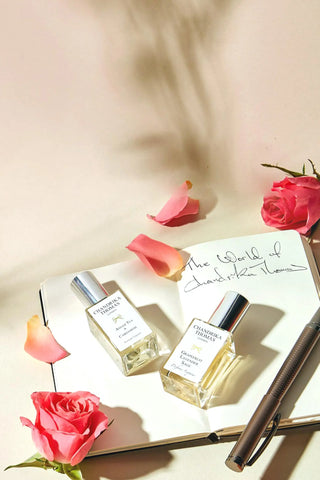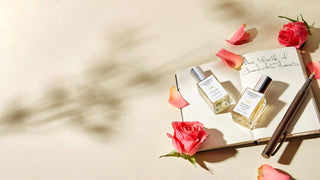Perfume is never static; it moves and breathes with its surroundings. The warmth of summer, the crispness of autumn, the stillness of winter, or the gentle bloom of spring all alter how a fragrance unfolds on the skin. What feels airy and radiant in May may fade too quickly in October, while notes that overwhelm in July can feel exquisite in cooler air. Each season creates its own stage on which perfume performs.
The reason lies in chemistry. Perfume is built from molecules that evaporate at different speeds, and weather changes how we experience them. Heat intensifies brightness and projection, cool air slows diffusion, and humidity influences longevity. Autumn, with its lower temperatures and heavier fabrics, becomes the season where denser notes, spices, woods, and resins truly come into their own, while lighter, fleeting accords struggle to leave much of a trail.
To help you curate your seasonal wardrobe of scent, let us explore the ingredients to embrace in autumn for depth and longevity, and those to use more sparingly, so your perfumes feel perfectly attuned to the season.


The Science of Scent and Weather
A perfume is a carefully balanced composition of top, heart, and base notes. These layers are shaped by molecular weight:
-
Light molecules (citrus fruits, delicate florals) evaporate quickly, producing an immediate but short-lived sparkle.
-
Heavier molecules (woods, resins, musks) evaporate slowly, releasing their richness over hours.
In autumn, three factors alter this balance:
-
Cooler air slows evaporation. Light molecules fade more quickly in cool, dry air, while heavier notes radiate with elegance.
-
Projection softens. In summer, warmth amplifies diffusion; in autumn, perfumes tend to sit closer to the skin unless composed with denser ingredients.
-
Clothing absorbs scent. Fabrics such as wool, tweed, and cashmere hold fragrance differently from bare skin, favouring notes with weight and persistence.
This explains why some perfumes bloom magnificently in autumn, while others falter.

Ingredients to Embrace in Autumn
Autumn is the season for perfumes with body and texture, scents that wrap around you like cashmere or velvet. Here are the notes that harmonise beautifully with crisp, cool air:
-
Spices (cardamom, nutmeg, cinnamon, pink pepper): Naturally diffusive and warming, these cut through cold air with vibrancy, adding both energy and comfort. A perfume with spice feels like a brisk autumn walk followed by mulled wine.
-
Woods (cedarwood, sandalwood, rosewood, oud): Dense and grounding, woods radiate slowly and provide structure. Their richness lingers elegantly in cooler weather.
-
Resins and balsams (myrrh, frankincense/olibanum, benzoin, labdanum): These unfold gradually and cling beautifully to fabric, bringing a warm, almost candle-like aura, perfect for evenings by the fire.
-
Gourmand notes (cocoa, vanilla, tonka, coffee): In summer, they can feel overpowering, but in autumn’s cool air, they soften into indulgent comfort, recalling spiced puddings, steaming mugs, and seasonal treats.
-
Rich florals (rose, jasmine, tuberose): While lighter florals fade, dense absolutes with body pair beautifully with woods and spices. They feel romantic and enduring, never fragile.

Ingredients to Avoid or Use Lightly in Autumn
Just as one would not wear linen in November, certain ingredients belong to warmer months. In autumn, they may feel fleeting, unbalanced, or simply out of place:
-
Sheer citruses (lime, grapefruit, bergamot on their own): Their light molecules sparkle briefly but fade too quickly in cool air unless anchored by richer notes.
-
Aquatic or marine accords: Designed to evoke freshness and humidity, these often feel flat in autumn’s cool, dry air, lacking the buoyancy they display in summer.
-
Delicate spring florals (lily of the valley, peony, lilac): These airy blossoms work best in sunshine. Against autumn’s richness, they fade swiftly, leaving little impression.
-
Overly sweet gourmands: While cocoa and vanilla can be divine, sugar-like accords may feel cloying indoors. The key is balance, sweetness softened by spice, wood, or resin.

How to Curate an Autumn-Friendly Perfume Wardrobe
Choosing perfumes for autumn is rather like changing one’s wardrobe. Fabrics shift from linen and silk to tweed and cashmere; perfumes, too, should reflect texture and depth.
-
Balance freshness with weight. Opt for perfumes that open with citrus or spice but settle into woods or resins for longevity.
-
Choose higher concentrations. Eau de parfum or extrait formulas last longer in cool weather, while lighter eaux de toilette may vanish too soon.
-
Layer with intention. Just as scarves and coats hold warmth, fabrics hold fragrance. Spraying onto knitwear or a scarf allows denser notes to diffuse softly and endure.
-
Think in textures. Citrus is linen, spices are cashmere, resins are velvet, and woods are tweed. Fragrance, like fashion, should dress the season.

Choosing perfume for autumn is not simply a matter of taste, but of understanding how scent behaves. Light, airy molecules sparkle briefly before vanishing; denser notes radiate with elegance, leaving a lasting impression. This is the beauty of seasonal perfumery: art meeting science, lifestyle guided by chemistry.
Autumn perfumes are about depth, warmth, and quiet glamour. They transform fragrance from something fleeting into something enduring, a companion for the season’s rituals and moods. By embracing the ingredients that thrive in cool air and setting aside those that falter, you create a perfume wardrobe that is as refined, intentional, and timeless as autumn itself.
Looking for more inspiration? Explore our other fragrance guides for autumn, where we highlight seasonal favourites, layering tips, and the perfect scents to carry you through the colder months. And for a beautifully curated introduction, discover our Full Perfume Discovery Set, an elegant way to experience the richness of Chandrika Thomas London perfumes and find the perfect spiced or woody signature to complement the season.



